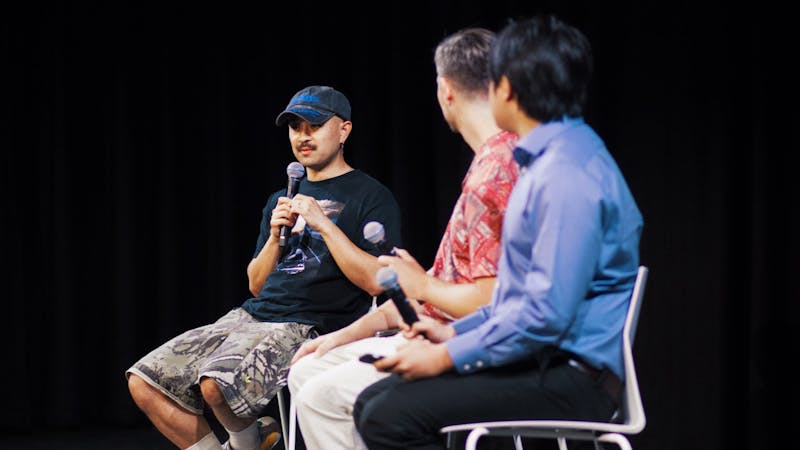Interdisciplinary gallery opens in arts district
The Washington Avenue Arts District is believed to have the highest concentration of working artists in the state of Texas, and the opening of the SITE Houston exhibition presented a microcosm of this cultural hub. The space featured 30 Houston artists, whose work is as diverse as their backgrounds.
The Silos at Sawyer Yard occupies one of Houston’s oldest buildings, a former rice warehouse in the First Ward. SITE Houston makes use of the silos which were used to store rice by repurposing them as individual artist’s spaces. The silos are arranged in the style of a honeycomb with one to three entrances each. Visitors make their way from room to room in the approximately 9,000-square-foot space. The comprehensive experience in the gallery is unique; each artist’s space is completely immersive, a cylinder containing each installation. The spaces in between each room, however, retain a dominantly industrial feel, leaving bare the history of the building.
Lina Dib, creator of one of the installations, is both a Houston artist and a professor at Rice. Dib teaches First-Year Writing Intensive Seminar courses for the Program in Writing and Communication and holds a doctorate in anthropology.
Her piece, “Pool of Sound,” fills one silo with blue light and the sound of water in response to the motion of the viewer.
Sound has become an important part of Dib’s academic and artistic life following anthropology research she conducted in the United Kingdom, which included exploring the relationship between sound and memory.
“I like playing with the idea of making the invisible visible,” Dib said. “Or at least palpable, into something you can feel. So maybe it’s an argument against empty space, or at least the interconnectedness of things.”
Another moment of intersection of Dib’s interests in anthropology and art is in the life of the building, one of few in Houston that has stood for over a hundred years.
“Tonight I met someone who used to work here; the reason she came was because she spent 29 years working in this rice packing facility and wanted to see what the space has turned into,” Dib said. “That was really interesting, to get to hear stories from someone who inhabited this building when it was a completely different building.”
Gary Watson and Syd Moen also took interest in the life of the building. Their piece, “Silos Project,” documents the space in two distinct ways. One side of their silo is devoted to Watson’s more traditional photography, while Moen’s side runs clips of her 360-degree videography.
“Silos Project” documents the nature of the building before and during its transformation into its current purpose.
“You still felt like there was something left from the prior use of the building,” Watson said. “There was this feeling that somebody had just walked away from work one day and had just left the building … As I walked around … I was looking for the details, the signs of prior life in the building … so that I could capture the essence of what had gone on before.”
Moen’s 360-degree videography captures a panoramic and incredibly busy view of the warehouse, contrasting with Watson’s static black and white images.
“I’ve been playing with 360-degree imagery for over 15 years, [since] the very beginning,” Moen said. “It’s a great opportunity to play in a historical building and to try out new technology.”
Aaron Courtland’s “Space Station in the Silos,” meanwhile, makes use of a projector and mirrors.
“I wanted to explore space more abstractly,” Courtland said. “So in the rotating images on the projector you’ll see different interpretations of space: clouds, water, landscapes, and as they hit over a thousand mirrors inside the silo they have these light prisms of color that dance on the opposite wall.”
Other installations included a wide variety of mediums and themes. “Passage” by Trey Duvall drips water onto a block of clay, slowly changing its shape over the course of its display. Nadia Pacheco and Andrea Porter’s “Which way to the rice?” features gentle flower patterns made of rice covering the floor. “Silo Flower” places the viewer inside of the petals of a giant vinyl flower, its stamens strands of flashing blue lights.
SITE Houston is located at 1502 Sawyer Street, in the Washington Avenue Arts District and has no admission fee. It will be open Saturdays from 5-9 p.m. until Jan. 30.
More from The Rice Thresher

Worth the wait: Andrew Thomas Huang practices patience
Andrew Thomas Huang says that patience is essential to being an artist. His proof? A film that has spent a decade in production, a career shaped by years in the music industry and a lifelong commitment to exploring queer identity and environmental themes — the kinds of stories, he said, that take time to tell right.

Andrew Thomas Huang puts visuals and identity to song
Houston is welcoming the Grammy-nominated figure behind the music videos of Björk and FKA twigs on June 27.

Live it up this summer with these Houston shows
Staying in Houston this summer and wondering how to make the most of your time? Fortunately, you're in luck, there's no shortage of amazing shows and performances happening around the city. From live music to ballet and everything in between, here are some events coming up this month and next!

Please note All comments are eligible for publication by The Rice Thresher.